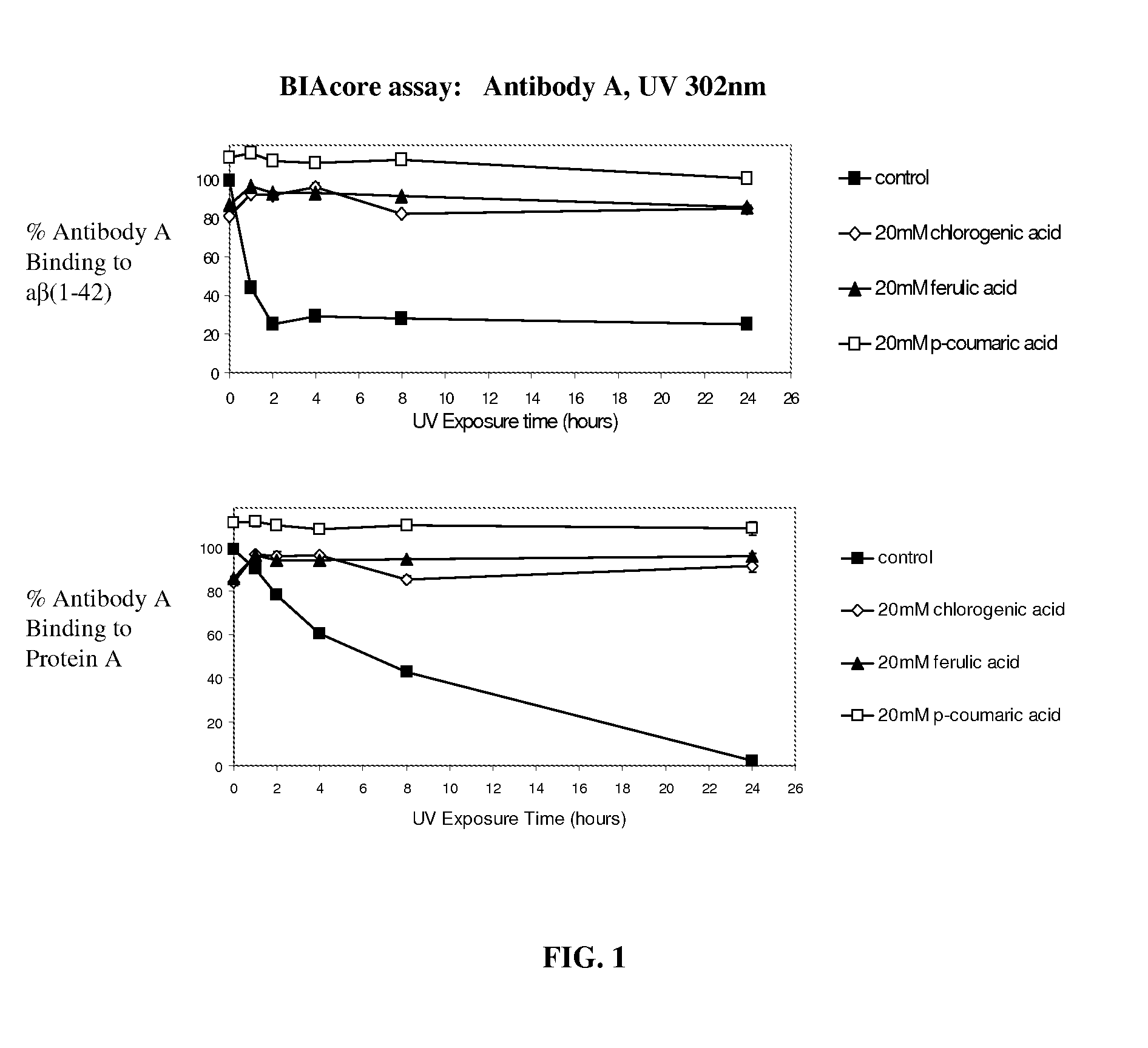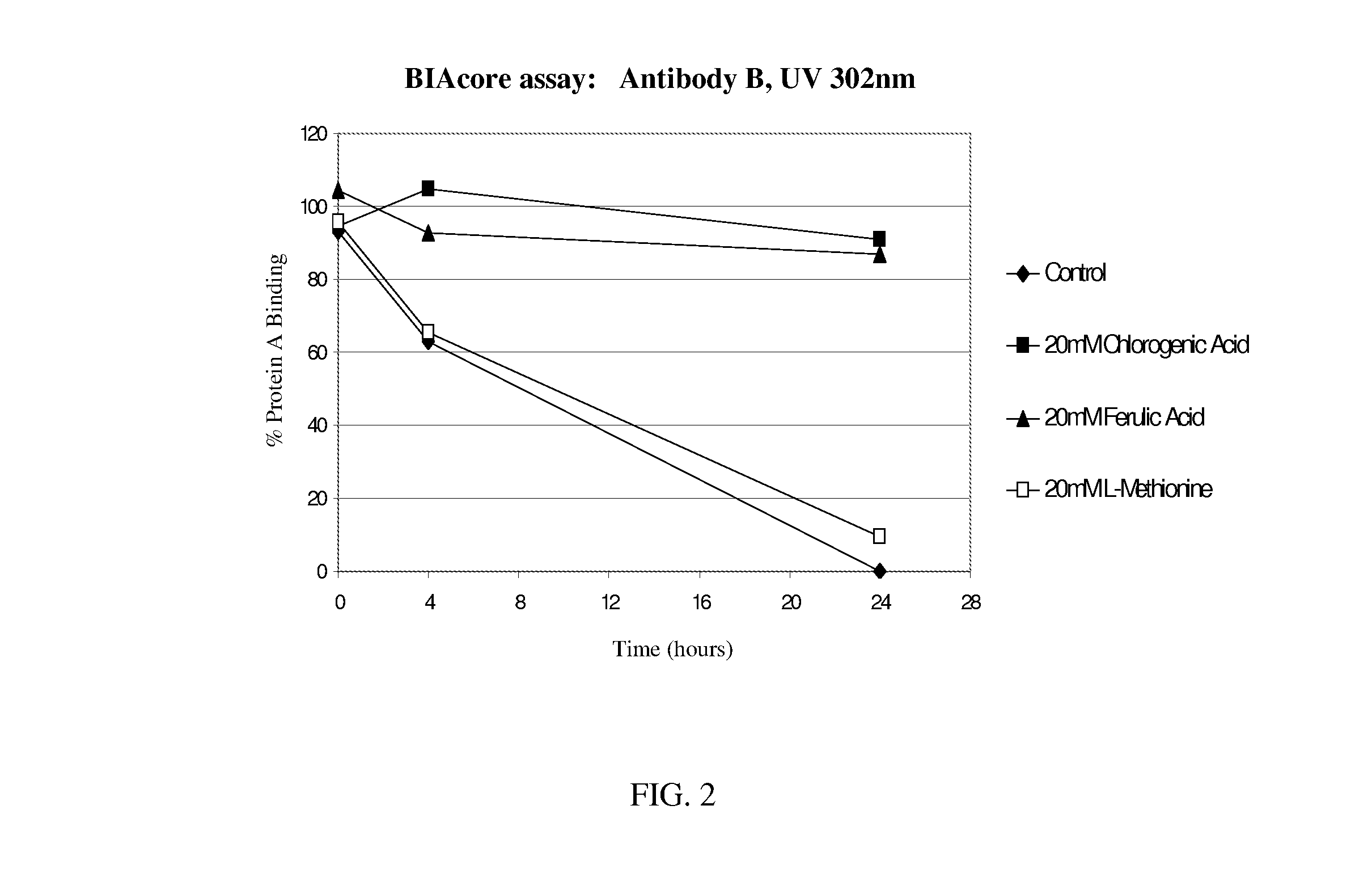Aqueous formulation of erythropoiesis stimulating protein stabilised by antioxidants for parenteral administration
a technology of antioxidants and erythropoiesis, which is applied in the direction of antibody medical ingredients, peptide/protein ingredients, extracellular fluid disorders, etc., can solve the problems of protein degradation, loss of biological activity, yellowing of protein solution, etc., and achieves superior stability and/or resistance to oxidation
- Summary
- Abstract
- Description
- Claims
- Application Information
AI Technical Summary
Benefits of technology
Problems solved by technology
Method used
Image
Examples
example 1
Effect of Cinnamic Acid Derivative on Binding Activity of Therapeutic Proteins
[0199]The binding activity of various therapeutic proteins in aqueous formulations containing an antioxidant were assessed as described below.
[0200]FIG. 1 shows the binding of Antibody A, an IgG1 monoclonal antibody, to its target antigen and protein A. Antibody A was formulated at pH 5.20 in acetate buffer. The exposure of Antibody A to 302 nm UV light caused a decrease in the binding to both of these ligands over the course of 24 hours. This binding was preserved by the addition of antioxidants chlorogenic, ferulic, or coumaric acid at a concentration of 20 mM.
[0201]FIG. 2 shows the effect of UV-B exposure on another IgG1 monoclonal antibody, Antibody B. Antibody B is the 1119 antibody of US Patent Application No. US 2005 / 0004353, which binds specifically to human interferon gamma. The sequence and properties of the 1119 antibody are fully described in US Patent Application No. US 2005 / 0004353, which is ...
example 2
Effect of Cinnamic Acid Derivative on Aggregation of Therapeutic Proteins
[0203]The aggregation of various therapeutic protein formulations was assessed in the manner described below.
[0204]FIG. 4 (EPO), FIG. 5 (anti-streptavidin), and FIG. 6 (Antibody A) show SEC-HPLC chromatograms of each proteins following exposure to 302 nm UV-B light for 24 hours. For FIG. 4, the EPO formulation was prepared having the following characteristics: 1 mg / mL EPO, 25 mM sodium phosphate, 125 mM sodium chloride, and pH 6.90. For FIG. 5, the anti-streptavidin formulation was prepared having the following characteristics: 1 mg / mL anti-streptavidin mAb (IgG2), 10 mM sodium acetate, 5% sorbitol, and pH 5.00. For FIG. 6, the Antibody A formulation was prepared having the following characteristics: 1 mg / mL Antibody A (IgG1), 10 mM sodium acetate, 9% sucrose, and pH 5.20.
[0205]These figures show the amount of aggregate for each protein formulation is dramatically reduced when the formulation contains 20 mM of ...
example 3
Effect of Varying Amounts of Cinnamic Acid Derivatives on Binding Activity and Aggregation of Therapeutic Proteins
[0206]The efficacy of varying amounts of different antioxidants were assessed in the manner described below.
[0207]FIG. 7 shows SEC-HPLC results for EPO formulations with the following characteristics: 0.336 mg / mL EPO, 20 mM sodium phosphate, and pH of 6.90, 0.1, 10, and 20 mM methionine or ferulic acid were added to the formulation. Each formulation was then exposed to 302 nm UV-B light for 24 hours. The protein formulation was then analyzed using SEC-HPLC. The results showed that ferulic acid at concentrations as low as 0.1 mM were able to reduce the amount of EPO dimer and aggregate caused by UV light exposure. Even 0.1 mM ferulic acid was able to prevent EPO degradation more effectively than 10 mM methionine.
[0208]FIG. 8 shows antibody-binding results for EPO formulations having 0, 0.10 mM, 10 mM, or 20 mM coumaric acid between 0 and 24 hours exposure to UV-B radiatio...
PUM
| Property | Measurement | Unit |
|---|---|---|
| Fraction | aaaaa | aaaaa |
| Fraction | aaaaa | aaaaa |
| Power | aaaaa | aaaaa |
Abstract
Description
Claims
Application Information
 Login to View More
Login to View More - R&D
- Intellectual Property
- Life Sciences
- Materials
- Tech Scout
- Unparalleled Data Quality
- Higher Quality Content
- 60% Fewer Hallucinations
Browse by: Latest US Patents, China's latest patents, Technical Efficacy Thesaurus, Application Domain, Technology Topic, Popular Technical Reports.
© 2025 PatSnap. All rights reserved.Legal|Privacy policy|Modern Slavery Act Transparency Statement|Sitemap|About US| Contact US: help@patsnap.com



